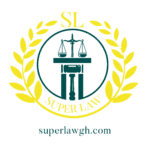Division: IN THE COURT OF APPEAL
Date: 2ND NOVEMBER, 1959.
Before: VAN LARE AG. C.J., GRANVILLE SHARP J.A. AND OLLENNU J.
JUDGMENT OF VAN LARE AG. CJ.
On the 27th October, 1959 we allowed this appeal from a judgment of the Judge of the Land Court, Sekondi, by which he set aside a decision in favour of the defendant in the Shama Native Court “B”
(His lordship stated the history of the case, and continued.)
We think that this can be regarded as being in the nature of a boundary dispute between two adjoining land owners, and the
[p.364] of [1959] GLR 362
burden therefore rested upon the plaintiffs to establish with particularity the extent of the land which they claimed and the boundaries of it. This the plaintiffs lamentably failed to do.
On the plaintiff s own admission it was established that the defendants had been in long undisturbed possession and occupation of the land, including that portion of the land on which the controversial house had been built, and were therefore entitled to the full protection of the law against anyone except a person who could affirmatively prove a better title. It is clear that the onus upon the plaintiffs in this case was heavy in the extreme.
The evidence as to title was mainly of a traditional character on each side, and we ourselves cannot find much to choose between the two conflicting stories. Following the decision in Kodilinye v. Mbanefo Odu (2 W.A.C.A. 336 at p. 338) we must emphasise that if the whole evidence in a case be conflicting and somewhat confused, and there is little to choose between the rival traditional stories, the plaintiff fails in the decree he seeks, and judgment must be entered for the defendant.
We observe that the Native trial-Court proceeded to their decision upon an application of these principles. They concluded their judgment as follows:
“Examining the whole record carefully on its merits and demerits and the inspection, the court is satisfied beyond any shadow of doubt that the plaintiffs have not been able to establish any case against the defendants.”
The Native trial-Court accordingly entered judgment in favour of the defendants.
In these circumstances, surprisingly (as it seems to us) the learned Judge of the Land Court called upon Counsel for the successful defendants to show cause why the judgment of the Native trial-Court should not be set aside, and judgment entered for the plaintiffs. In response to this invitation leaned Counsel, as it appears on the record, gave a full and satisfactory enunciation of the law to which we have referred, in relation to the facts of the case. Despite this the learned Judge, without calling upon learned Counsel for the plaintiff, concluded by expressing his opinion “that the plaintiffs satisfactorily proved their case and discharged the onus of proof which lay on them.” The only reason appearing in his judgment is that in his view the evidence given on behalf of the plaintiff family was conclusive.
[p.365] of [1959] GLR 362
We cannot agree that such evidence was conclusive, and we ought to add that the learned Judge appears to have failed to give any consideration to the evidence as a whole, which (as we have already indicated) was in conflict, and in some confusion as to tradition. Had he given due consideration to the matter he would have been led to the conclusion that judgment must be given against the plaintiffs, who in such circumstances had failed to discharge the burden of proof that rested upon them. In our opinion, therefore, the learned Judge of the Land Court erred in reversing the decision of the Native trial-Court.
